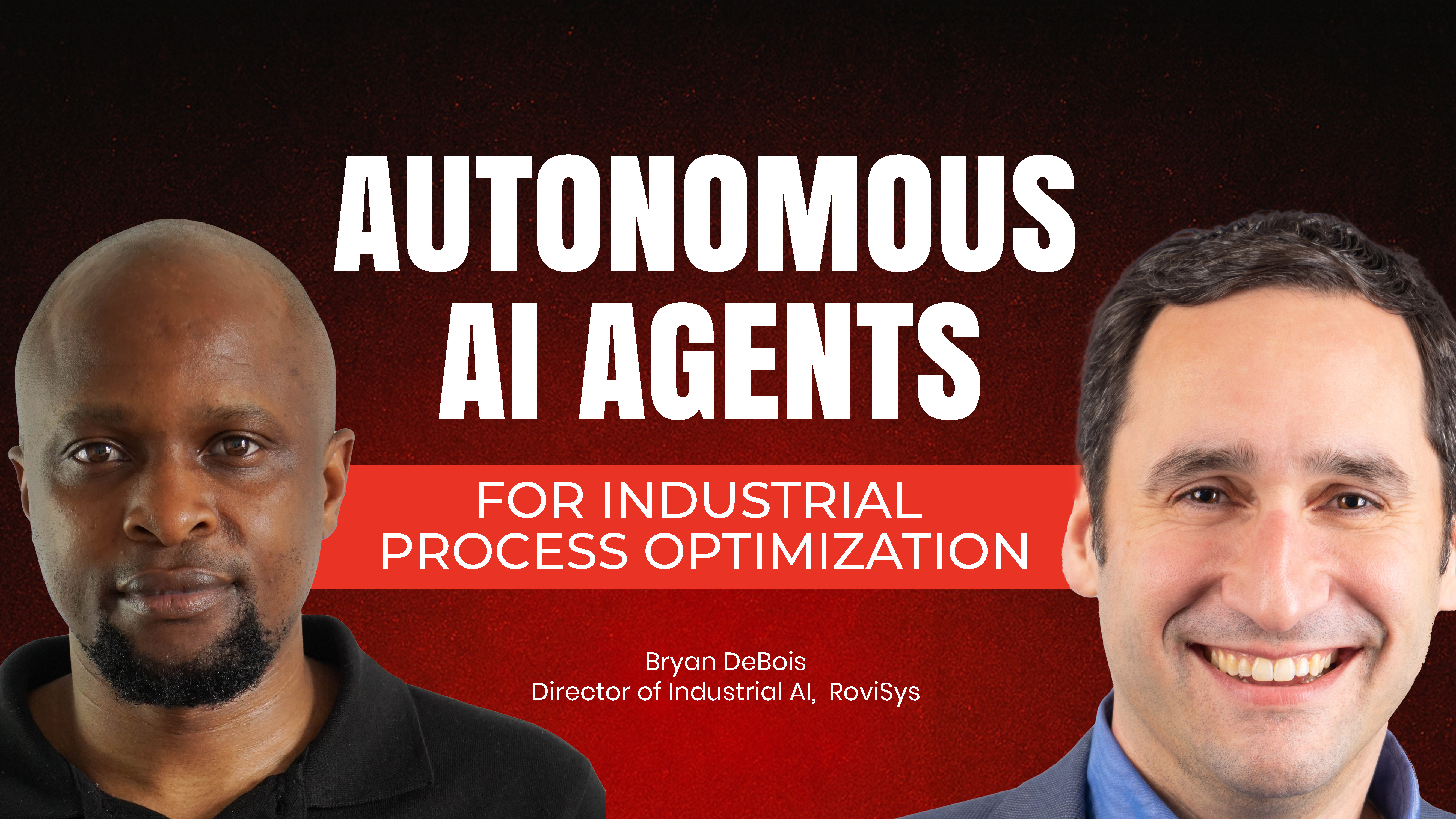November 2, 2025

Here's something most industrial AI vendors won't tell you: building a great AI model is the easy part. Getting it to actually work on your plant floor and deliver ROI? That's where most projects die.
Brian DeBois, Director of Industrial AI at RoviSys, has spent 25 years in manufacturing and six years specifically building AI solutions for the plant floor. His team has learned one critical lesson: operationalizing AI, not just building it, is where the real value lives. And after 75% of AI models never make it to production, it's clear the industry needs a different approach.
The Expertise Crisis Driving Industrial AI Adoption
Manufacturing faces a knowledge emergency that's accelerating faster than most realize. The numbers tell a stark story: in 2019, the average tenure for US manufacturing workers was 20 years. By 2023, it had collapsed to just three years.
This isn't just about headcount. When veteran operators retire, they take decades of nuanced knowledge with them, the kind that can't be captured in a manual:
- The difference between on-spec and optimized: Expert operators at a vinyl manufacturer could produce material that met specifications while using minimal raw materials. Newer operators made "heavy vinyl" that technically passed quality checks but wasted roughly $1 million annually in excess material.
- The ability to recover quickly: At a glass bottle manufacturer, expert operators could bring processes back on-spec in 7-20 minutes when things went wrong. An AI agent trained on their expertise reduced this to under 5 minutes, a 50% improvement that dramatically reduced waste.
- Throughput optimization: Experienced operators know exactly how hard they can push equipment without breaking it. This institutional knowledge directly impacts how much product moves through your lines.
The real question for data leaders isn't whether to adopt AI. It's whether you can afford to let this expertise walk out the door without capturing it first.
Why Your Plant Floor Needs Different AI Than Your Office
Most executives think "AI" means large language models like ChatGPT. That's creating dangerous misconceptions about what works on the plant floor.
Generative AI excels at knowledge problems, writing emails, summarizing documents, answering questions. But plant floors face operational problems, and generative AI has a fundamental limitation: it can't reason about cause and effect. Apple proved this in a study in October 2024, demonstrating that these models can't understand causal connections.
The plant floor needs autonomous AI built on deep reinforcement learning instead:
- Causal reasoning: Unlike generative AI, autonomous AI can understand that "if I adjust this temperature, then that pressure will change, which will affect product quality." This cause-and-effect reasoning is essential for process control.
- Real-time optimization: These systems continuously adjust dozens of parameters throughout the day, finding efficiency gains that humans miss because the problems are too complex to solve manually.
- Machine teaching approach: You can train autonomous AI agents by having your expert operators explain their decision-making process—essentially transferring their knowledge before they retire.
This doesn't mean generative AI has no role in manufacturing. It's powerful for documentation, knowledge management, and communication. But when you need an AI to actually control or optimize processes, reach for autonomous AI instead.
Why Operationalizing AI Matters More Than Model Accuracy
Here's the uncomfortable truth: until someone on your plant floor actually makes a decision based on your AI model's recommendations, you haven't seen any ROI. Everything before that point is just an expensive science project.
This is where data science teams often stumble. They're excellent at building models in corporate offices but rarely understand what it takes to run something 24/7 in a production environment:
- The deployment gap: Data scientists who've never visited the plant floor struggle to put their models into production. Even talented AI vendors often lack the operational technology experience needed to integrate with plant systems.
- Support and maintenance: Who retrains the model? Who troubleshoots when it stops working at 2 AM? Who handles version control? These aren't data science questions, they're operational questions.
- Change management: Getting operators to trust an AI model over their own instincts and experience requires careful organizational change management. You can't just drop a black box on the plant floor and expect adoption.
The solution is treating operationalization as a first-class concern from day one, not an afterthought. That means involving plant operations early, planning for maintenance, and building trust gradually through decision support before moving to closed-loop control.
Building Data Infrastructure That Actually Works
Before you can operationalize AI, you need the data infrastructure to support it. The good news: if you've spent the last decade collecting data in historians, you're not starting from scratch.
The typical industrial AI architecture builds in layers:
- Data collection layer: Time-series historians capturing sensor data every few seconds from plant equipment. Some newer facilities skip on-premise historians and send data directly to cloud storage, both approaches work.
- Data integration layer: Cloud platforms that correlate data from multiple sites, different historian brands, and various systems (not just plant floor data but also ERP, warehouse management, maintenance systems). One manufacturer discovered their filler clogs only occurred when specific raw material suppliers' products sat in the warehouse too long on particular production lines, a pattern impossible to spot without integrating multiple data sources.
- ML operations layer: Platforms like AWS SageMaker or Azure ML that provide the tools to build, deploy, and manage models at scale.
The key insight: there's value at every layer, not just at the final AI model. Better dashboards, clearer insights, and improved data quality all deliver ROI before you train your first model.
Practical Takeaways: An Industrial AIRoadmap That Actually Works
Forget proof-of-concept purgatory. The most successful AI implementations solve real problems from day one, even if the initial scope is narrow.
Start with a structured approach:
- Workshop phase: Spend half a day teaching your team what's possible, then brainstorm 20-40 AI project ideas. Down-select to the highest-impact, lowest-cost opportunities.
- Assessment phase: Pick 2-3 projects and flesh them out completely. Talk to all stakeholders, examine data sources, estimate ROI, identify the right vendors for your ecosystem, and put real dollar amounts on everything.
- Solution phase: Build something that solves an actual problem—not a proof of concept. Start narrow (one production line, a few products) to reduce risk, but make it production-ready from day one. Then scale to other lines once it's proven.
Track the right metrics for your specific goals. One life science manufacturer focused on sustainability metrics and reduced energy consumption by 8-12% through AI-optimized environmental controls. A vinyl manufacturer tracked material thickness to eliminate $1 million in annual waste. Your metrics should align with what you're optimizing, throughput, quality, energy, or waste.
Most importantly, baseline everything before you start. You can't prove ROI if you don't know where you started.
The Bottom Line
The future of manufacturing AI isn't about building smarter models. It's about getting the models you build into production where they can actually deliver value.
That requires a fundamentally different approach: treating operationalization as job one, choosing the right AI technology for plant floor problems, building proper data infrastructure, and solving real problems instead of running endless pilots.
The expertise crisis isn't slowing down. The manufacturers who figure out how to operationalize AI successfully won't just maintain their competitive edge, they'll capture the knowledge of their best operators before it walks out the door forever.
Your competitors are already taking their first steps. The question isn't whether to start, but whether you can afford to wait.
Kudzai Manditereza is an Industry4.0 technology evangelist and creator of Industry40.tv, an independent media and education platform focused on industrial data and AI for smart manufacturing. He specializes in Industrial AI, IIoT, Unified Namespace, Digital Twins, and Industrial DataOps, helping digital manufacturing leaders implement and scale AI initiatives.
Kudzai hosts the AI in Manufacturing podcast and writes the Smart Factory Playbook newsletter, where he shares practical guidance on building the data backbone that makes industrial AI work in real-world manufacturing environments. He currently serves as Senior Industry Solutions Advocate at HiveMQ.



